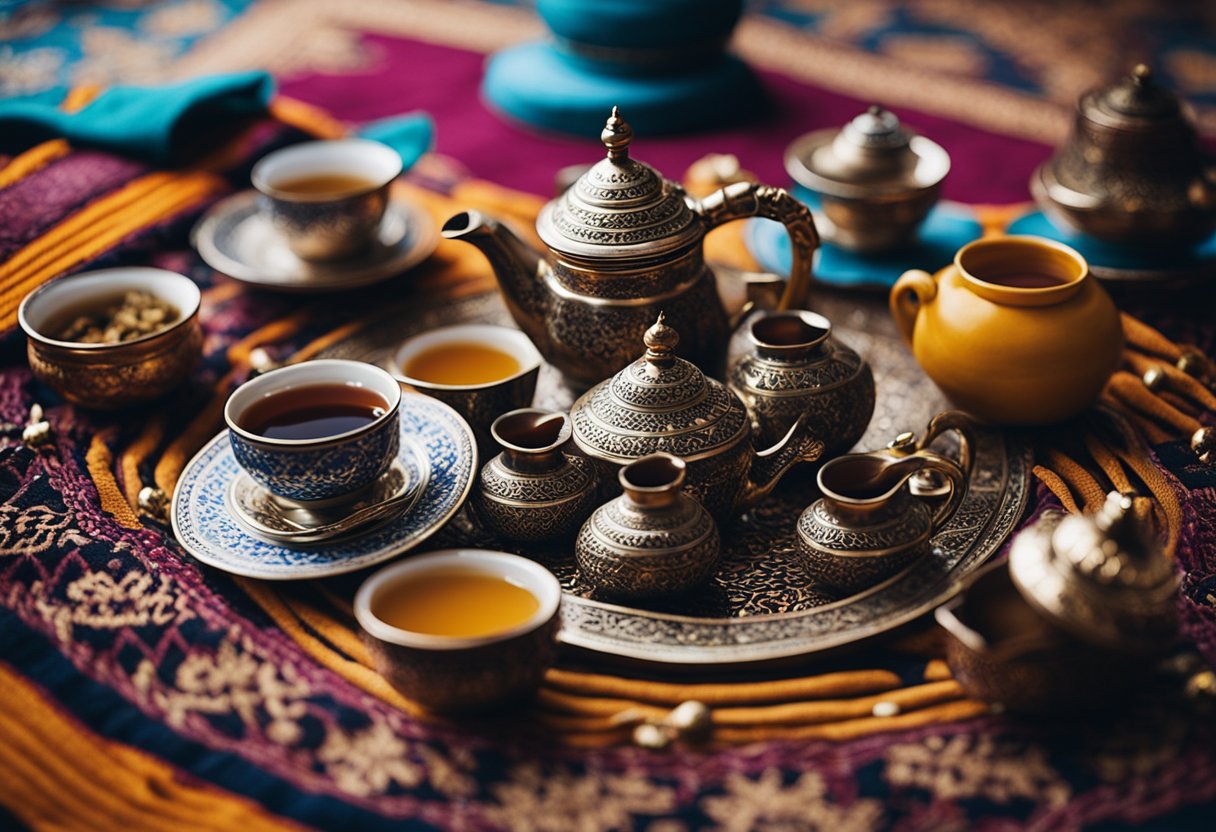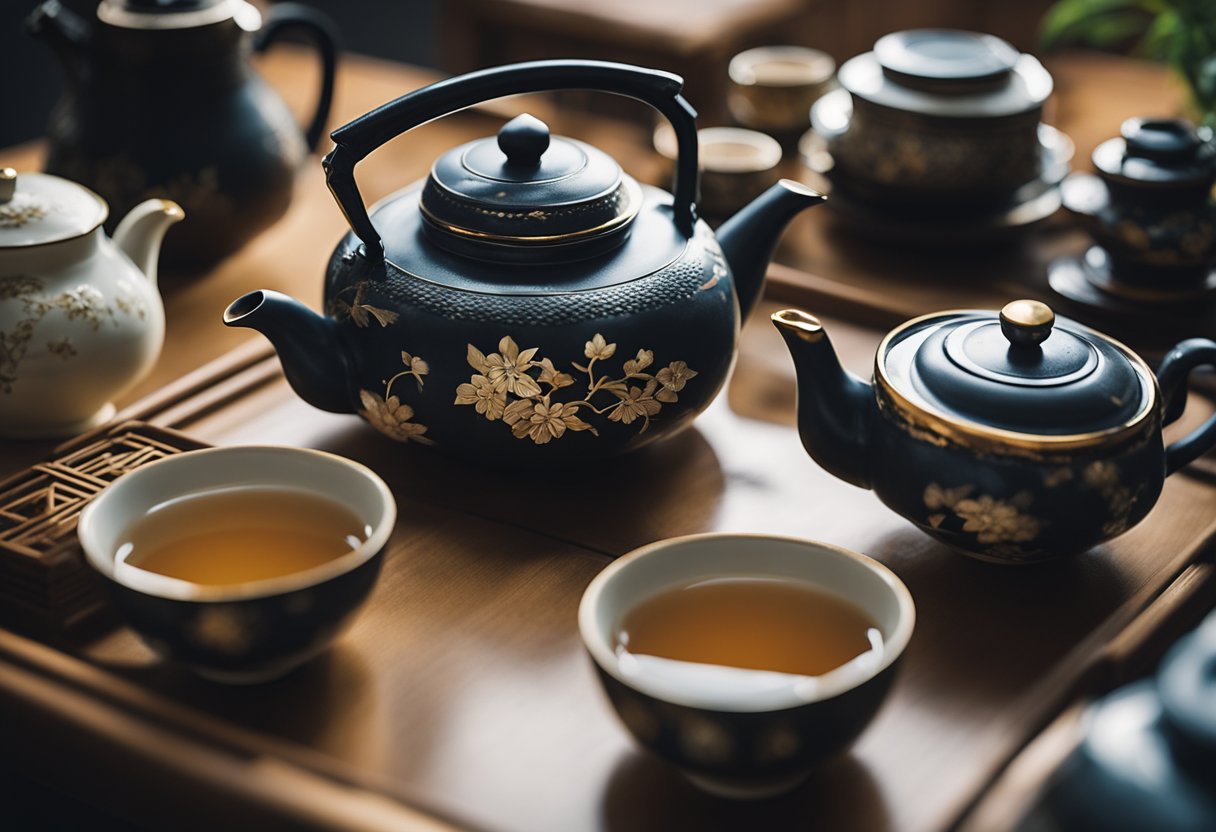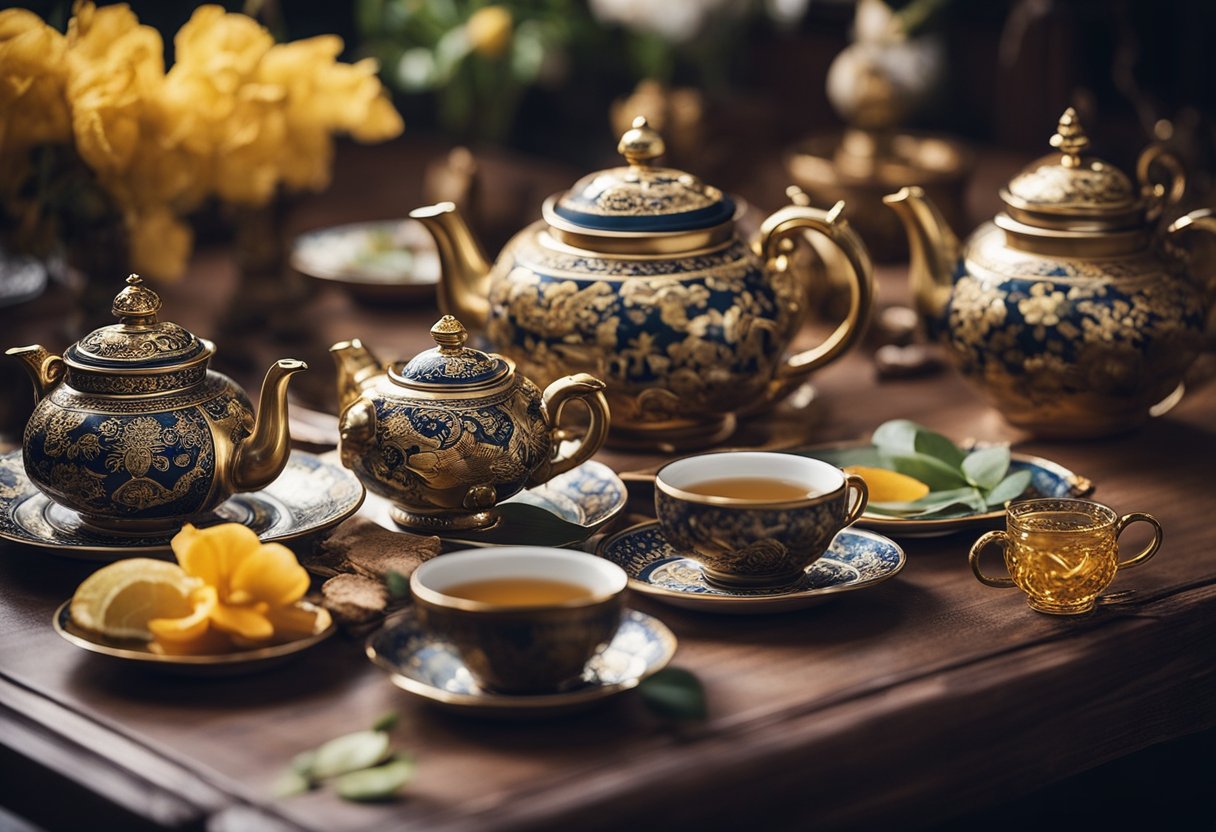Tea Traditions Across Cultures: Exploring Global Ceremonies and Celebrations

Updated On: April 15, 2024 by Raghda Elsabbagh
Across different cultures and countries, tea has emerged as a beverage deeply integrated into the fabric of society. This simple drink, derived from the Camellia sinensis plant, boasts a multitude of ceremonies and traditions that vary widely from one location to the next. While some rituals focus on the meticulous preparation and consumption of tea, others see it as a centrepiece for social gatherings and a gesture of hospitality. The historical origins of tea drinking trace back thousands of years, developing into an elaborate tapestry of cultural significance that ranges from everyday pleasure to profound spiritual practice.

The varied methods of tea blending and preparation, the significance of tea-related etiquette, and the selection of teaware underscore the complex relationship between tea and social status. In many societies, tea rituals are imbued with philosophical and ritualistic elements that offer a window into the spiritual life of communities. These practices can often reveal hierarchical structures within a culture, as well as the manner in which tea facilitates social bonds. Tea ceremonies, from the Japanese chanoyu to the English afternoon tea, embody a shared experience, a moment in time dedicated to the appreciation of the art of tea.
Table of Contents
Historical Origins of Tea Drinking
As we explore the tapestry of tea’s past, it is fascinating to see how a humble leaf transformed into a global phenomenon.
The Discovery of Tea
Legend speaks of Emperor Shen Nong, who, according to Chinese folklore, discovered tea in 2727 BC. It is said that when leaves from a wild tree blew into his pot of boiling water, they created an enticing brew that captivated the emperor with its aroma and flavour. This accidental infusion marked the beginning of tea’s story. For factual accuracy, it’s important to note that this is a mythological account and not a verified historical event.
Tea on the Silk Road
Tea’s popularity grew steadily in China, with the first definitive written accounts by Lu Yu in the Tang Dynasty through his work “The Classic of Tea”. He detailed the art and culture of tea making and drinking. Its influence quickly spread beyond borders via the Silk Road, an extensive network of trade routes connecting the East to the Mediterranean. This led to the introduction of tea to other cultures, securing its place as a globally revered beverage.
Tea, indeed, became a vital commodity on these routes, one that was exchanged alongside silk, spices, and ideas, allowing for both the physical and cultural proliferation of tea-drinking traditions.
Cultural Significance of Tea Ceremonies
Tea ceremonies are rich ceremonial practices that embody the customs and values of their respective cultures. Each has its unique set of rituals steeped in history and philosophy.
Chinese Tea Ceremony
The Chinese tea ceremony, known as gongfu, is a detailed and artistic expression of tea brewing. This practice involves precise steps and the use of specific teaware to accentuate the flavours of the tea. The ceremony is not merely about drinking tea but is also a form of meditation and a demonstration of respect and manners.
Japanese Tea Ceremony
The Japanese tea ceremony, or chado and chanoyu, represents a choreographed art that integrates the principles of Zen Buddhism. It is more than just serving and receiving tea; it’s a spiritual journey fostering mindfulness and harmony. The ritual preparation and consumption of matcha, a powdered green tea, is central to this ceremony, reflecting purity, tranquillity, and reverence for the guests.
Other Notable Tea Traditions
Tea traditions span the globe, each with its own cultural significance. In many countries, tea ceremonies are integral to social gatherings and celebrations, such as in Morocco, where mint tea is served to guests as a sign of hospitality. Similarly, in the United Kingdom, afternoon tea is an enduring practice that signifies a pause and enjoyment in the day, often accompanied by scones, sandwiches, and pastries.
Tea and Social Hierarchy
The ritual of tea drinking is intertwined with social hierarchy, which is especially notable in the United Kingdom, where it became a symbol of social status and prestige.
Tea in the United Kingdom
In the United Kingdom, tea is more than a beverage; it’s a social institution that reflects the class stratification of British society. Afternoon tea, a tradition reputedly started by the Duchess of Bedford in the early 19th century, became a social event amongst the upper class. This afternoon break filled the long gap between meals, and soon, high tea evolved into a gathering defined by its formal settings and elaborate manners, acting as a display of wealth and refinement.
Tea in the Aristocracy
For the aristocracy, tea was a means to showcase one’s exemplary taste and social standing. Gentlefolk would gather in drawing rooms, where the finest porcelain and silver were used to serve tea. Invitations to these tea parties were coveted, as they were seen as indicators of one’s social acceptance by the upper echelons of society. These events were characterised by strict etiquette, where every detail, from the brewing of tea to the tiered cake stands, was choreographed to reflect the host’s sophistication and the guests’ adherence to the social hierarchy.
Spiritual and Ritualistic Elements
In exploring the world of tea, we uncover profound connections to spirituality and meticulous rituals that transcend mere consumption. The acts of preparing and savouring tea are deeply interwoven with principles of mindfulness and tradition.
Buddhism and Tea
In Buddhism, tea is more than a soothing beverage; it’s an integral part of spiritual practice. Historically, monks drank tea to remain alert during long meditation sessions. The Zen philosophy embodies simplicity and mindfulness, principles that are carefully woven into the tea rituals, exemplified by the concept of wabi-sabi, the acceptance of imperfection and transience. Sen No Rikyu, a historical figure in the tea community, asserted the importance of harmony (wa), respect (kei), purity (sei), and tranquillity (jaku) in the tea ceremony, fostering a spiritual communion among participants.
Tea as Meditation
Tea ceremonies can indeed serve as a form of meditation. The repetitive and intentional motions required in the preparation of tea encourage a meditative state, bringing a sense of calm and tranquillity to both practitioner and guest. This mindful engagement is a hallmark of the Japanese tea ceremony, inviting participants to focus on the present moment and achieve purity of mind and spirit. Regardless of the cultural context, the ritualistic component of tea preparation and enjoyment promotes an introspective journey echoing the meditative traditions found across various cultures.
Global Tea Practices
Tea, a drink treasured worldwide, has taken on unique forms and ceremonial significance across various cultures.
Moroccan Mint Tea Rituals
In Morocco, the preparation of mint tea is a gesture of hospitality and is deeply ingrained in the country’s social fabric. The tea, a blend of green tea leaves, fresh mint, and a generous amount of sugar, is traditionally served three times to guests. The pouring technique is as much a part of the ritual as the drinking; the tea is poured from a height to create foam on the surface, symbolising prosperity.
Russian Samovar Gatherings
The samovar, an iconic symbol in Russian tea culture, is central to social gatherings. It’s not merely a device to boil water; it’s a focal point for community and warmth. The water from the samovar is typically used to prepare strong black tea, which is then diluted to taste. Guests may add sugar, lemon, or even jam, partaking in a ritual that has been a cornerstone of Russian hospitality for centuries.
South American Yerba Mate Customs
In countries like Argentina, the drinking of yerba mate is a communal custom that transcends a mere beverage. This strong herbal drink is passed around in a gourd and sipped through a metal straw, known as a bombilla, reinforcing social bonds. The preparation and consumption of yerba mate follow a specific order, often beginning with the host, solidifying its role as a drink of friendship and respect.
The Art of Tea Blending and Preparation
We invite you to explore the intricate practices that shape the rich traditions of tea blending and preparation in different cultures. With a particular focus on Indian Chai and Japanese Matcha, we shall uncover the meticulous processes behind these beloved beverages.
Indian Chai
In India, chai is not merely a drink but a staple of daily life, richly woven into the fabric of society. The traditional Masala Chai is a spiced tea that combines black tea with a symphony of aromatic spices such as cardamom, cinnamon, ginger, and others, each chosen for their flavour and health benefits. The process begins by simmering these spices with water to extract their essence, then adding the tea leaves to infuse the brew with a robust character. Milk is added to create a creamy consistency, while sugar sweetens the concoction. The key to perfect chai is in the balance of spices, which can be adjusted for strength and flavour to suit individual tastes.
Japanese Matcha
In Japan, the preparation of Matcha is an art form and a spiritual practice, deeply entwined with the history and culture of the country. Matcha is a green tea powder renowned for its vibrant hue and nutritional benefits. The ceremonial presentation speaks volumes of its significance; the green tea leaves are meticulously stone-ground into a fine powder.
Water, at just the right temperature, is whisked with the matcha in a precise rhythm using a bamboo whisk known as a chasen. The result is a frothy, bright green emulsion that is both invigorating and meditative. The skill of the tea master is paramount in achieving matcha’s signature texture and flavour, which is revered in Japanese tea ceremonies as a symbol of harmony and purity.
Tea Consumption Trends
In the realm of tea, unique trends have emerged, reshaping the way we appreciate this ancient beverage. Two significant trends capturing consumer interest worldwide are the rise of bubble tea and the widespread popularity of iced tea variations.
Rise of Bubble Tea
Originally from Taiwan, bubble tea has stirred a global sensation. This beverage combines sweetened tea with milk or fruit flavourings and, most distinctively, includes chewy tapioca balls. Shops specialising in bubble tea have multiplied, particularly in urban areas, signifying a prominent shift in tea consumption, particularly among the younger demographic. Taiwan continues to be honoured as the birthplace of this innovative tea category.
Adoption of Iced Tea Variations
While traditional tea drinking maintains its stature, the adoption of iced tea variations is gaining immense popularity, especially in the U.S. From classic sweetened iced tea to fruit-infused blends, the spectrum of iced tea has expanded, incorporating a variety of flavours that cater to personal taste preferences. This refreshing interpretation of tea has not only appealed to those seeking a cool beverage but has also introduced tea to new audiences who may prefer a chilled drink over a hot cup.
Types of Tea and Their Cultural Ties
Tea is an integral part of many cultures around the world, with traditions and ceremonies built around its consumption. We recognise the importance of understanding the cultural ties of various types of tea, particularly black and green teas, and their unique place in societies.
Significance of Black Tea
Black tea is a beloved beverage steeped in history and cultural significance. In the Darjeeling region of India, the eponymous Darjeeling tea is known for its delicate flavour and is often referred to as the “Champagne of teas.” Revered for its nuanced taste, Darjeeling embodies the high-altitude terroir of its region.
Moving to a more robust variety, Assam tea, also from India, is cherished for its full-bodied, malty flavour, making it a robust start to the day in many British and Irish households. Meanwhile, Ceylon tea from Sri Lanka is renowned for its rich golden colour and brisk taste. It has become a symbol of national pride and a key export of the country.
The Popularity of Green Tea
Green tea, with its origins in ancient China, has transcended its initial ceremonial uses to become a daily ritual for people around the world. Sencha, a steamed green tea from Japan, offers a grassy, refreshing flavour and is the most consumed tea in the country, reflecting the Japanese ethos of natural simplicity.
Another Japanese green tea, genmaicha, combines sencha or bancha leaves with roasted brown rice. This tea was historically consumed by the poor as the rice served as a filler to reduce the cost, but it is now enjoyed by all segments of society, treasured for its toasty flavour.
Lastly, bancha, often considered a lower grade of Sencha due to its later harvest, offers a milder taste and is commonly enjoyed as a casual, everyday tea, demonstrating the Japanese tradition of wasting nothing.
Teatime Traditions and Accompaniments

As we explore the diverse world of tea traditions, the accompanying delicacies play a significant role in complementing the experience. Each culture adds a local flavour by pairing tea with a variety of sweet and savoury bites.
Sweets and Pastries
Tea time is often synonymous with indulging in scones, generously topped with clotted cream and jam. This British tradition, known as afternoon tea, typically includes a range of pastries and cakes, with each bite-sized delight offering a burst of flavour. A classic example is the Victoria Sponge, a light and airy cake filled with jam and dusted with sugar, encapsulating the quintessence of British tea-time.
- Scones: Often served with cream and jam.
- Pastries: Include a variety such as eclairs, tarts, and mille-feuille.
- Cakes: From the Victoria sponge to delicate fruitcakes.
Savoury Tea Pairings
Moving on to savoury options, we come across the versatile sandwiches that adorn the high tea platter. These range from the simple cucumber sandwich, a staple of elegance, to more elaborate fillings like smoked salmon and cream cheese. As we sip our tea, these savouries provide a perfect balance to the sweeter offerings.
- Sandwiches: With fillings like cucumber, eggs, and smoked salmon.
- Quiches: A savoury option often enjoyed with tea in France and broader Europe.
- Savoury Scones: Cheese or herb scones as an alternative to their sweet counterparts.
Pairing tea with the right food enhances the overall experience, allowing the flavours of both the brew and the bites to shine through in perfect harmony.
Tea-Related Hospitality and Etiquette
In different cultures, offering tea is not only about quenching thirst but also a gesture of hospitality and a sign of respect. We see these principles reflected in traditional customs and the manner in which tea is presented to guests.
Guest Welcoming Customs
- UK: Upon arrival, it is customary for hosts to offer guests a warm cup of tea, typically served with milk and sugar to suit individual tastes. This act signifies a warm welcome and provides an opportunity for conversation and relaxation.
- Turkey: Visitors are greeted with a glass of Turkish tea served in a tulip-shaped glass, often accompanied by sweets like sushki. The offering of tea is deeply embedded in social interactions and is considered a symbol of friendship and hospitality.
- India: Known for its Indian chai, chai wallahs (tea vendors) are a common sight, serving as social hubs where people from all walks of life gather, reflecting India’s inclusive approach to hospitality where everyone is welcome to a hearty cup of chai.
Respect and Formalities in Tea Offerings
- UK: When offering tea, it is considered polite to ask guests their preferences regarding strength, milk, and sugar. Pouring the tea and passing cups with both hands signifies respect and attentiveness to guests’ comfort.
- Turkey: Presenting tea from golden samovars is a mark of honour, indicative of the host’s respect for their guests. It also showcases their willingness to present the finest they have to offer.
Tea ceremonies and the accompanying etiquettes in various cultures serve as a bridge for social bonding, reflecting a shared value of honouring guests and creating moments of togetherness. Whether welcoming travellers or gathering friends, these customs depict the universal language of hospitality.
Tea Ware and Accessories

In this section, we explore the vital role of tea ware in brewing and the varying cultural approaches to tea accessories.
Evolution of Teaware
The journey of teaware from function to art reflects centuries of tradition and innovation. Initially, tea was brewed simply, but as the drink gained popularity, so did the desire for specialised vessels. In China, traditionally crafted teapots made from the clay of the Yixing region became valued for their ability to retain heat and enhance the flavour of tea. Over in Japan, the tea room, complete with tatami flooring, inspired teaware that harmonised with the serene aesthetics and ritual precision of the Japanese tea ceremony. In Taiwan, teaware has also seen advancement, from the meticulous pottery styles to the more modern, minimalist designs that suit contemporary preferences.
Cultural Differences in Tea Accessories
Each culture brings its own unique flair to the teaware and accessories used in their tea ceremonies. China’s tea culture highly regards the gaiwan, a lidded bowl used for infusing and drinking tea. Japanese ceremonies emphasise harmony and respect, utilising chawans (tea bowls) and chasen (bamboo whisks) as part of their tea rituals. These items are not merely functional but symbolise the deep cultural significance and meticulous attention to detail present in their tea traditions. Taiwan’s tea culture has also embraced the aesthetic aspect of teaware, with fine porcelain and delicate designs playing into the sensory experience of tea drinking.
Frequently Asked Questions

In this section, we explore the intricacies of tea traditions as they vary around the world, answering common inquiries about these cultural practices.
How do tea ceremonies differ around the globe?
Tea ceremonies reflect the unique cultural and spiritual beliefs of different regions. For example, the Japanese tea ceremony focuses on Zen Buddhist principles of mindfulness and simplicity, while in Morocco, the tea ritual is performed with flair and shared with guests as an act of hospitality.
Which countries are known for having a traditional tea time?
Countries renowned for their tea time traditions include the United Kingdom with its afternoon tea, India with its Chai breaks, and Turkey with its ubiquitous tea houses serving çay.
What are some common tea-time traditions observed worldwide?
Globally, tea time traditions often involve pairing the beverage with specific foods like scones and clotted cream during British afternoon tea or accompanying Moroccan mint tea with sweets. Hospitality and socialisation are central to these traditions, with tea acting as a communal beverage.
What roles does tea play in various cultures?
In many cultures, tea symbolises hospitality and is an important component in welcoming guests. It can also serve a ceremonial purpose, such as in Chinese Gongfu tea brewing, and it’s often linked to health and well-being, being incorporated into daily rituals for relaxation and social interaction.
Can you describe various types of tea ceremonies practised internationally?
Internationally, a range of tea ceremonies exists, including the formal and meditative Japanese Chanoyu, the elaborate Chinese Gongfu tea ceremony, and the informal but culturally significant Russian tea gatherings around a samovar.
What are the key similarities and differences in tea rituals around the world?
Key similarities in tea rituals include the use of tea as a means of socialising and hospitality. The differences lie primarily in the preparation methods, types of tea used, and the formalities of the ceremony. While some rituals, like the Southeast Asian ceremonies, can be informal and spontaneous, others, such as the Japanese tea ceremony, are meticulously structured and choreographed.






